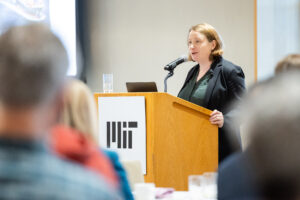Atmosphere, there, and everywhere
Breakfast with Noelle Selin, Professor of Atmospheric Chemistry and Director of the MIT Center for Sustainability Science and Strategy

Atmospheric chemist Noelle Selin delivers the Dean’s Breakfast talk on April 3, 2025. Photo: Steph Stevens
In the early morning of April 3rd, Noelle Selin, Professor of Earth, Atmospheric and Planetary Sciences (EAPS) and director of the MIT Center for Sustainability Science and Strategy, addressed an enthusiastic crowd of MIT alumni and friends on the topic of hazardous pollutants and strategies to mitigate their impacts on health.
Selin told the group, “As an Earth scientist, if I really think about understanding the Earth, I have to understand the humans in it as well.” She discussed two case studies to illustrate the need for circumspect approaches in tackling pollution: the insidious threat posed by mercury in the environment, and the risks of substituting ammonia for diesel as a fuel for maritime shipping.

Although humans have known for centuries that mercury is toxic, its unique properties have found applications in industries ranging from mining to medicine to makeup. Selin focused on atmospheric mercury and its primary sources: coal burning and small-scale gold mining. Mercury is a contaminant in coal, and emissions from powerplants release it into the air. Miners use mercury to efficiently harvest gold particles from waterways, binding the elements together and burning off the mercury to leave behind pure gold. When mercury enters the atmosphere, it circulates the globe and deposits in lakes and oceans, where it enters the food chain and can concentrate in human food sources like fish.
In 2013, nearly 140 countries, including the United States, signed the Minamata Convention, a treaty designed to protect humans and the environment from mercury and mercury compounds. The treaty targeted emissions and outlined tools for small-scale miners to reduce or eliminate their use of mercury. After a decade, atmospheric detectors available to Selin and her team found significantly reduced levels of the element. Displaying a map of the globe, however, she demonstrated that the detectors who made their data available were concentrated in Europe and North America, highlighting the positive impacts of treaties like Minamata as well as limitations in measuring its effect. In a study authored by former Institute for Data, Systems, and Society postdoc Ari Feinberg, researchers employed box modeling and 3D chemical transport models to account for data gaps and to inform hypotheses about the decline in atmospheric mercury – pointing to changes in human-made emissions as a likely explanation.
Turning to another source of atmospheric pollution, Selin explained the perceived benefits and unintentional consequences of employing ammonia as a fuel for maritime shipping. Because ammonia combustion produces no carbon dioxide, switching to ammonia from fossil fuels is a possible path to decarbonization. However, despite being carbon-free, ammonia produces other emissions–NOx, NH3, and N2O–which could worsen air quality. In a study led by Anthony Wong, a postdoc in the MIT Center for Global Change Science, scientists attempted to model the system impact of this switch. They considered scenarios with two types of ammonia ship engines and three differing sets of regulatory policy to calculate emissions and their impact on pollution and human health.
Smarter modeling takes human interaction with the environment into account. Flexible, reconfigurable models can help to untangle complex environmental knots. In the case of mercury and ammonia, models shed light on the push and pull of human behavior, policy, public health, and science. Selin’s work brings this climate knowledge to other sectors and international decision-makers. “With some simple things,” she says, “we can make a lot of progress.”
Jesse Feiman | School of Science